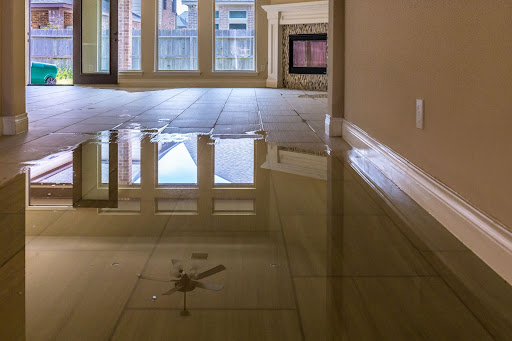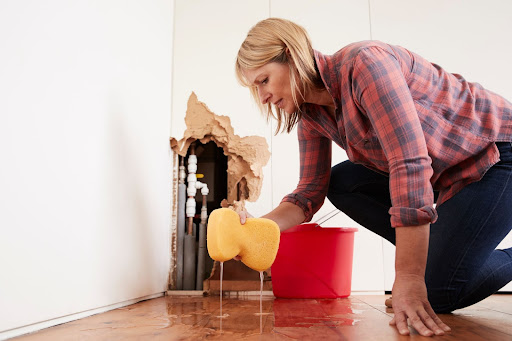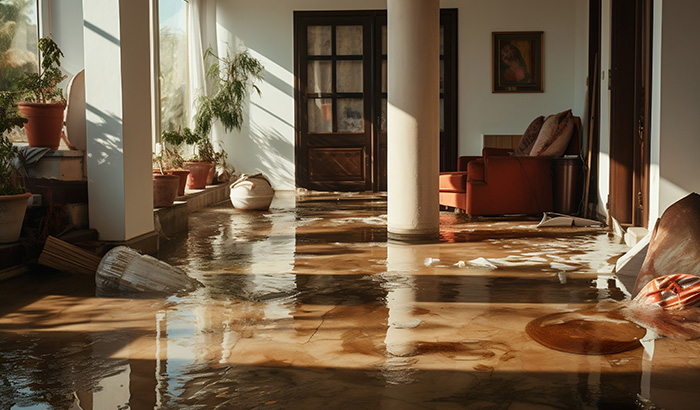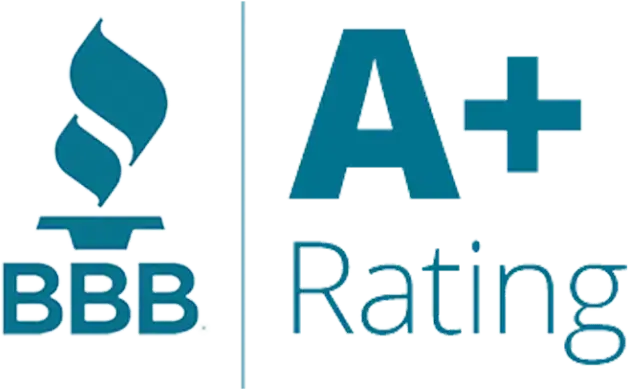Experiencing a house flood is a distressing event for any homeowner. The immediate aftermath leaves you feeling uncertain about the future. It becomes more daunting when you start thinking about flood damage restoration.
Many homeowners have navigated the challenges of a house flood and emerged stronger on the other side, and with the proper steps and guidance, you will, too.
Our comprehensive guide on flood restoration aims to provide you with a clear roadmap to navigate the aftermath of a flood, ensuring your home returns to its former glory.
Step 1: Prioritize Safety
In the immediate aftermath of a house flood, your and your loved ones’ safety should be your top priority. While the urgency to begin flood restoration may be pressing, ensuring everyone is out of harm’s way first is crucial.
Evacuate if Necessary: If the flood levels are high or rising rapidly, evacuate the premises. Find a safe location away from the floodwaters, such as a neighbor’s house or a community shelter.
Avoid Electrical Hazards: Floodwaters pose significant electrical risks. Before venturing into any flooded area of your home, ensure the main power is turned off. This precaution will help prevent potential electrical shocks, a common and dangerous hazard during house floods.
Stay Out of the Water: Floodwaters get contaminated with sewage, chemicals, and other harmful substances. It’s best to avoid direct contact. If you must enter a flooded area, wear protective clothing, including rubber boots and gloves.
Nothing is more important than your safety. By taking these precautions, you’re laying a solid foundation for the subsequent steps in the flood restoration process.

Step 2: Turn Off Utilities
One of the first proactive measures is to secure your home’s utilities. This step is for everyone’s safety and sets the stage for a smoother flood damage restoration process.
Safely Access the Main Power Switch: Before beginning flood restoration efforts, turn off the electricity to prevent potential electrical hazards. Turn it off if you can safely reach your home’s main power switch without wading through water. If you’re unsure or feel it’s unsafe, it’s best to consult with a professional or wait for assistance.
Turn Off Gas Valves: Gas leaks are a hidden danger after a house flood. If you smell gas or suspect a leak, turn off the main gas valve. If you’re uncertain how to turn it off, seek professional guidance.
Step 3: Contact Local Authorities
Navigating the aftermath of a house flood is a harrowing experience. Local authorities have resources and expertise to assist residents.
Reporting the Flood: If the flooding in your home results from natural disasters or affects multiple properties in your area, report it to local authorities. Local government agencies and community organizations often offer support services, from emergency shelters to financial assistance.
Follow Guidelines or Instructions: Local authorities may have specific protocols or recommendations for residents affected by flooding. Adhering to these guidelines ensures you’re taking the proper steps in line with community safety standards.
Step 4: Document Damage
It’s natural to want to jump straight into the cleanup and flood damage restoration process. Before diving in, document the extent of the damage. This step, while seemingly administrative, significantly impacts your recovery journey.
Capture Comprehensive Images: Use a camera or smartphone to take clear photos of all affected areas. Ensure you capture wide shots to show the overall damage and close-ups of specific items or structural damage.
Video Documentation: In addition to photos, consider taking videos. A walkthrough video will provide a more dynamic view of the damage, capturing aspects that photos might miss.
List Damaged Items: Create a detailed inventory of damaged items, including their estimated value. This list will be invaluable when discussing compensation with your insurance company.
Store Documentation Safely: Ensure that all documentation, including photos, videos, and lists, is stored in a safe and accessible location. Consider backing up digital files to cloud storage or an external drive.
Documenting the damage provides you with the necessary evidence to navigate insurance claims and other aspects of the flood restoration process.
Step 5: Notify Your Insurance Company
After a house flood, one of the most essential steps in the flood restoration journey is contacting your insurance company. This is vital in ensuring you receive the support and compensation you’re entitled to.
Initiate the Claims Process: Contact your insurance company immediately to report the flood. The sooner you initiate the claims process, the quicker you receive guidance and potential financial assistance for flood damage restoration.
Provide Detailed Information: Share the documentation you’ve gathered, including photos, videos, and the list of damaged items. This comprehensive evidence will help substantiate your claim and provide a clear picture of the extent of the damage from the house flood.
Understand Your Coverage: Familiarize yourself with the specifics of your insurance policy. Knowing what’s covered, from structural damage to personal belongings, will give you a clearer understanding of the support to expect. Ask your insurance representative if you’re unsure about any aspect of your coverage.
Step 6: Begin Cleanup and Salvage Efforts
Embarking on the cleanup process after a house flood is overwhelming, but with a systematic approach, you will efficiently mitigate the damage and set your home on the path to recovery.
Remove Water: Start by removing any standing water in your home. Depending on the amount of water, use sump pumps, wet vacuums, or even buckets. The quicker you remove the water, the better you prevent further damage and potential mold growth.
Ventilate the Area: Proper ventilation is essential — open windows and doors to allow fresh air to circulate. If you have fans or dehumidifiers, use them to expedite drying. This step is crucial in preventing mold and mildew.
Salvage What You Can: As you go through the cleanup, identify items that can be saved and cleaned. However, be cautious with items like electronics, which might be irreparably damaged by water.
Dispose of Damaged Items: Some items, especially those soaked by contaminated water, should be discarded. Follow local guidelines for disposing of flood-damaged items.
Stay Protected: Always wear protective gear during the cleanup, including gloves, masks, and rubber boots. This will shield you from potential contaminants in the water and any mold spores that might be present.
Step 7: Disinfect Areas and Dry Out Property
The next crucial phase in your flood restoration journey is ensuring that your home is free from contaminants and thoroughly dried out. This step is vital for the long-term health and safety of its occupants.
Disinfect the Affected Areas: Floodwaters, especially from sources like rivers or sewers, introduce a range of contaminants into your home. Once the water is removed, thoroughly disinfect all affected surfaces. Use recommended disinfectants and cleaning agents to ensure that all areas are free from bacteria, mold, and other potential hazards.
Dry Out the Property: With disinfection underway, focus on drying your home. Moisture is a breeding ground for mold, so it’s essential to eliminate it as quickly as possible. Use fans, dehumidifiers, and natural ventilation to speed up drying. Depending on the extent of the house flood, this may take several days.
Be patient and ensure areas are thoroughly dried before moving on to repairs.
Monitor for Signs of Mold: Even after disinfection and drying, stay vigilant for signs of mold growth. If you notice mold patches or a musty odor, address it immediately. In some cases, you might need professional mold remediation services to ensure your home is safe and healthy.
Remember, the goal is not just to repair the visible damage but to ensure that your home remains a safe and healthy environment in the long run.

Step 8: Repair and Restore
Once you’ve navigated the immediate challenges of a house flood, it’s time to focus on the longer-term recovery of your home. In the repair and restoration phase, you’ll rebuild and rejuvenate your space, transforming it back into the sanctuary it once was.
Assess Structural Damage: Begin by evaluating the structural integrity of your home. Floodwaters weaken foundations, damage walls, and compromise the overall stability of a structure. Identify any areas that need reinforcement or repair to ensure the safety of your home.
Consider Professional Contractors: Depending on the extent of the damage, hiring professional contractors specializing in flood restoration is a logical move. These experts have the tools, knowledge, and experience to address complex repair issues, restoring your home to the highest standards.
Prioritize Essential Repairs: Focus on areas that are key for the safety and functionality of your home, such as electrical systems, plumbing, and roofing. Addressing these areas first ensures your home is livable while other, less urgent repairs are underway.
A house flood is a setback, but with determination, the right resources, and a focus on quality, your home will again stand as a testament to resilience and recovery.
Trust Pando Plumbing for Your Water Damage Restoration Needs
In the aftermath of a house flood or any water-related emergency, the road to recovery may seem overwhelming. Restoring your home to its former glory is entirely achievable with the right expertise and support. With our specialized Water Damage Restoration services, Pando Plumbing stands as a beacon of hope for homeowners in Draper, Utah, and beyond.
When dealing with water damage, Pando Plumbing understands that every second counts. Our dedicated crew is always ready to deploy in emergencies, equipped with the necessary tools to remove water swiftly and address the root of the problem. We ensure a comprehensive solution by investigating the issue’s source and reviewing your pipes for optimal safety and functionality.
Moreover, Pando Plumbing goes the extra mile by recommending top-notch carpet and wood restoration companies, ensuring your home is restored as quickly and efficiently as possible.
When facing the aftermath of a house flood or any water damage, remember that Pando Plumbing is a call away, ready to guide you through the flood restoration process. Contact Pando Plumbing to restore your home to its former glory.




